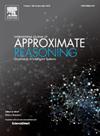Stable structure learning with HC-Stable and Tabu-Stable algorithms
IF 3
3区 计算机科学
Q2 COMPUTER SCIENCE, ARTIFICIAL INTELLIGENCE
引用次数: 0
Abstract
Many Bayesian Network structure learning algorithms are unstable, with the learned graph sensitive to arbitrary dataset artifacts, such as the ordering of columns (i.e., variable order). PC-Stable [1] attempts to address this issue for the widely-used PC algorithm, prompting researchers to use the ‘stable’ version instead. However, this problem seems to have been overlooked for score-based algorithms. In this study, we show that some widely-used score-based algorithms, as well as hybrid and constraint-based algorithms, including PC-Stable, suffer from the same issue. We propose a novel solution for score-based greedy hill-climbing that eliminates instability by determining a stable node order, leading to consistent results regardless of variable ordering. The new Tabu-Stable algorithms achieve the highest overall performance in terms of mean BIC score, log-likelihood, and structural accuracy across networks. These results highlight the importance of addressing instability in structure learning and provide a robust and practical approach for future applications. This paper extends the scope and impact of our previous work presented at Probabilistic Graphical Models 2024 [2] by incorporating continuous variables, implementing new stable orders that improve performance further, and demonstrating that the approach remains effective in the presence of sampling noise. The implementations, along with usage instructions, are freely available on GitHub at https://github.com/causal-iq/discovery.

HC-Stable和Tabu-Stable算法的稳定结构学习
许多贝叶斯网络结构学习算法是不稳定的,学习到的图对任意数据集工件敏感,例如列的顺序(即变量顺序)。PC- stable[1]试图为广泛使用的PC算法解决这个问题,这促使研究人员转而使用“稳定”版本。然而,这个问题似乎被基于分数的算法所忽视。在本研究中,我们证明了一些广泛使用的基于分数的算法,以及混合和基于约束的算法,包括PC-Stable,都存在同样的问题。我们提出了一种基于分数的贪婪爬坡的新解决方案,通过确定稳定的节点顺序来消除不稳定性,从而导致无论变量顺序如何结果一致。新的Tabu-Stable算法在平均BIC分数、对数似然和跨网络的结构精度方面实现了最高的总体性能。这些结果强调了解决结构学习中不稳定性的重要性,并为未来的应用提供了一个强大而实用的方法。本文扩展了我们之前在概率图形模型2024[2]上提出的工作的范围和影响,通过合并连续变量,实现进一步提高性能的新稳定顺序,并证明该方法在存在采样噪声的情况下仍然有效。实现以及使用说明可以在GitHub上免费获得https://github.com/causal-iq/discovery。
本文章由计算机程序翻译,如有差异,请以英文原文为准。
求助全文
约1分钟内获得全文
求助全文
来源期刊

International Journal of Approximate Reasoning
工程技术-计算机:人工智能
CiteScore
6.90
自引率
12.80%
发文量
170
审稿时长
67 days
期刊介绍:
The International Journal of Approximate Reasoning is intended to serve as a forum for the treatment of imprecision and uncertainty in Artificial and Computational Intelligence, covering both the foundations of uncertainty theories, and the design of intelligent systems for scientific and engineering applications. It publishes high-quality research papers describing theoretical developments or innovative applications, as well as review articles on topics of general interest.
Relevant topics include, but are not limited to, probabilistic reasoning and Bayesian networks, imprecise probabilities, random sets, belief functions (Dempster-Shafer theory), possibility theory, fuzzy sets, rough sets, decision theory, non-additive measures and integrals, qualitative reasoning about uncertainty, comparative probability orderings, game-theoretic probability, default reasoning, nonstandard logics, argumentation systems, inconsistency tolerant reasoning, elicitation techniques, philosophical foundations and psychological models of uncertain reasoning.
Domains of application for uncertain reasoning systems include risk analysis and assessment, information retrieval and database design, information fusion, machine learning, data and web mining, computer vision, image and signal processing, intelligent data analysis, statistics, multi-agent systems, etc.
 求助内容:
求助内容: 应助结果提醒方式:
应助结果提醒方式:


